Where you see this button
Spider Collector's Journal (16th page: 2006) Copyright © 2006 by Rod Crawford
As explained on the first page, most of these notes of fun
(and not so fun) trips to collect spiders for research at the Burke
Museum appeared in Scarabogram, newsletter of "Scarabs:
The Bug Society," in their original forms. References to the editor
mean me; most other persons mentioned are Scarabs members. Dates of field
trips head each paragraph. Maps showing the location of sites within Washington
state follow the grid system outlined in the Washington
Spider Checklist. RETURN TO INDEX
Where you see this button ![]() in a
field trip account, click it to get a page of collecting site photos!
in a
field trip account, click it to get a page of collecting site photos!
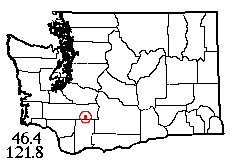 |
![]() 10 II 2006: Since yr editor's last field trip in November, it hadn't
stopped raining long enough to dry out the bushes in months. Finally, this month
we had a fairly nice week, and on Feb. 10, Mary Yoder-Williams (a Scarab in
the old days) and I went to look for Microhexura, which her friend Joel
Harp in Tennessee wanted for live rearing studies. They are tiny funnel
web making spiders, smallest species in the tarantula suborder, and have an
endangered cousin
living in North Carolina. Microhexura idahoana, the species in the Cascades,
is widespread in old growth from Mt. Rainier southward, living in rotten logs
and moss, and is known to wander around on the snow in February, thus making
them (we hoped) easy to find!
10 II 2006: Since yr editor's last field trip in November, it hadn't
stopped raining long enough to dry out the bushes in months. Finally, this month
we had a fairly nice week, and on Feb. 10, Mary Yoder-Williams (a Scarab in
the old days) and I went to look for Microhexura, which her friend Joel
Harp in Tennessee wanted for live rearing studies. They are tiny funnel
web making spiders, smallest species in the tarantula suborder, and have an
endangered cousin
living in North Carolina. Microhexura idahoana, the species in the Cascades,
is widespread in old growth from Mt. Rainier southward, living in rotten logs
and moss, and is known to wander around on the snow in February, thus making
them (we hoped) easy to find!
Armed with somewhat
out of date snow info from the Forest Service web site, we headed for Randle
on the White Pass Highway and tried to find snow on Lone Tree Mountain to the
south. Not a flake to be found! So we spent part of the day driving into the
south Cascade hinterlands toward Baby Shoe Pass and Walupt Lake, only to find
the roads blocked by downed trees. Some snow was visible on nearby peaks, but
out of our reach. So, giving up on snow collecting, we went back to Lone Tree
and a beautiful mature forest stand I'd found on an aerial photo, with tall
hemlocks (some were big in diameter too) and a mossy understory with nice logs,
all vivid green in the low-angled winter sunshine (see
album). In the short time available, collecting from logs, moss, understory
and conifer foliage was pretty good, netting 2 unfamiliar species among the
15 caught, one of them a small burrowing Antrodiaetus from logs. But
no Microhexura. I'd hoped a leaf litter sample gathered at the last minute
would bring us up to 20 species, but the litter turned out to be poor spider-wise
and left me one short. Oh well - good excuse for another trip! It was nice to
stop on the way home for a burger at the Huff and Puff, an old field biologists'
hangout just outside Randle. Driving back to Seattle via the "back way"
through Eatonville, we glimpsed Mt. Rainier by moonlight.
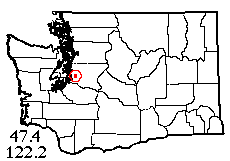 |
![]() 6 IV 2006: I haven't gone collecting with local-bus transport in years,
but on doing an inventory of places with incomplete spider samples, one turned
out to be near Kent in Seattle's southern suburbs. So on an appropriate half-day,
I hopped a 197 bus which delivered me within walking distance of a greenbelt
I'd found on aerial photos. This belt (a slope too steep for building) is lined
with houses at top and bottom, but a road winding down gave access at a switchback.
I was prepared to find the habitat badly damaged by invasive blackberry, but
there wasn't too much, and the small area where I collected looked good. However,
not far beyond here the greenbelt was badly invaded by English ivy (see
album). As the sun emerged from lowering clouds, Pardosa wolf spiders
became active in the clearing. Leaf litter sifting gave 11 species (4 of them
non-native), and smaller numbers were found in understory foliage (including
an uncommon Trogloneta), field foliage, cedar foliage, and under rubble.
Two of the best species were from an old stump with fire-blackened bark. A pleasant
day, showing it's still possible (with planning) to collect in the suburbs.
Reinspecting the airphoto later, I found I'd been practically in some people's
back yards, though the houses were 60' above me.
6 IV 2006: I haven't gone collecting with local-bus transport in years,
but on doing an inventory of places with incomplete spider samples, one turned
out to be near Kent in Seattle's southern suburbs. So on an appropriate half-day,
I hopped a 197 bus which delivered me within walking distance of a greenbelt
I'd found on aerial photos. This belt (a slope too steep for building) is lined
with houses at top and bottom, but a road winding down gave access at a switchback.
I was prepared to find the habitat badly damaged by invasive blackberry, but
there wasn't too much, and the small area where I collected looked good. However,
not far beyond here the greenbelt was badly invaded by English ivy (see
album). As the sun emerged from lowering clouds, Pardosa wolf spiders
became active in the clearing. Leaf litter sifting gave 11 species (4 of them
non-native), and smaller numbers were found in understory foliage (including
an uncommon Trogloneta), field foliage, cedar foliage, and under rubble.
Two of the best species were from an old stump with fire-blackened bark. A pleasant
day, showing it's still possible (with planning) to collect in the suburbs.
Reinspecting the airphoto later, I found I'd been practically in some people's
back yards, though the houses were 60' above me.
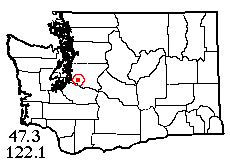 |
![]() 18 IV 2006: April showers had scrubbed a more ambitious trip the previous
week, so when the sun emerged on Tuesday, I hopped a three-bus parlay for another
suburban pick-up trip, to the south end of the Soos
Creek Regional Trail next to Lake Meridian. The trail is part of a new long
skinny park cobbled together out of a riparian stream belt plus railroad and
powerline rights-of-way. Having only a half day, I didn't hike too far north
but stopped at the first likely spot, a grassy clearing with mixed woods around
and a big stand of Spiraea shrubs at one side. All the most-detested
local invasive plants were present: Scots broom, the two blackberry species,
ivy, and holly, but none had taken over yet, even though houses were in sight
on each side of the corridor. Dicentra, food plant of parnassian butterflies,
was abundant in the understory. A few people were using the adjacent trail but
nobody came into my clearing as I chased wolf spiders, swept grass (with many
dandelions), beat Spiraea, forest understory, and conifer foliage, and
sifted alder litter, Spiraea litter, and moss. All these methods produced
spiders, and I fulfilled my goal with a total of 23 species, but the fauna proved
undiverse, mostly very common species (a couple were mildly interesting).
18 IV 2006: April showers had scrubbed a more ambitious trip the previous
week, so when the sun emerged on Tuesday, I hopped a three-bus parlay for another
suburban pick-up trip, to the south end of the Soos
Creek Regional Trail next to Lake Meridian. The trail is part of a new long
skinny park cobbled together out of a riparian stream belt plus railroad and
powerline rights-of-way. Having only a half day, I didn't hike too far north
but stopped at the first likely spot, a grassy clearing with mixed woods around
and a big stand of Spiraea shrubs at one side. All the most-detested
local invasive plants were present: Scots broom, the two blackberry species,
ivy, and holly, but none had taken over yet, even though houses were in sight
on each side of the corridor. Dicentra, food plant of parnassian butterflies,
was abundant in the understory. A few people were using the adjacent trail but
nobody came into my clearing as I chased wolf spiders, swept grass (with many
dandelions), beat Spiraea, forest understory, and conifer foliage, and
sifted alder litter, Spiraea litter, and moss. All these methods produced
spiders, and I fulfilled my goal with a total of 23 species, but the fauna proved
undiverse, mostly very common species (a couple were mildly interesting).
Heading back down
the main trail toward the road, I took what I thought was the side trail I'd
come in on. I soon realized my mistake, but I was going in the right direction
and through better habitats than any I'd seen yet, deep woods lacking invasives
and open marsh land with willow swamp. The hike seemed much too long - then,
almost out of the woods, I was brought up short by a high fence between me and
the road! I'd hiked down the wrong side of a huge mobile home "park"
and come out on the gated powerline access. I'm never lost for more than a few
minutes in the wilderness, but put me in a suburban greenbelt...
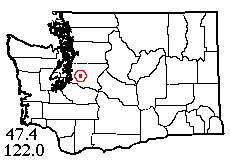 |
![]() 19 IV 2006: I'd been in touch with Erin Wojewodzki-Prinsen, co-owner
and caretaker of the private Shadow
Lake Sphagnum bog preserve in south King County, another area where
I needed more records. She had wanted me to sample spiders there years ago but
somehow it never happened. This time it did! After a somewhat late start due
to unaccustomed city traffic, we arrived by midday and strolled down the lovely
boardwalk from the Prinsens' home into the uppermost part of the bog. I quickly
discovered that this part is in a very late successional stage, with no pools
and a lot of the Sphagnum replaced by other moss species. So we drove
around to the lower end of the property (separated from Shadow Lake by a gated
road and lakefront lots). Squelching up a trail that needed rubber boots, I
thought this was more like it.
19 IV 2006: I'd been in touch with Erin Wojewodzki-Prinsen, co-owner
and caretaker of the private Shadow
Lake Sphagnum bog preserve in south King County, another area where
I needed more records. She had wanted me to sample spiders there years ago but
somehow it never happened. This time it did! After a somewhat late start due
to unaccustomed city traffic, we arrived by midday and strolled down the lovely
boardwalk from the Prinsens' home into the uppermost part of the bog. I quickly
discovered that this part is in a very late successional stage, with no pools
and a lot of the Sphagnum replaced by other moss species. So we drove
around to the lower end of the property (separated from Shadow Lake by a gated
road and lakefront lots). Squelching up a trail that needed rubber boots, I
thought this was more like it.
The bog is a patchwork
of mid-sized open areas with Ledum (aromatic Labrador tea) and Sphagnum
hummocks (but only a few small pools), with bog forest areas (pure western hemlock)
in which the moss in the hummocks is largely replaced by non-Sphagnum
species. We set up in a forest patch to sift Sphagnum from the surrounding
bog areas, getting plenty of promising small spiders. While I was doing that,
Erin helped immensely by beating spiders from the Ledum with my spare
net - she got about a third of the total species. With an hour to go (Erin had
to make it to a meeting) I beat hemlock foliage, then headed through shoulder-high
Ledum to get a bag of leaf litter in an alder thicket I'd spotted in
the distance. It turned out that the alder woods fringing the bog is invaded
by cutleaf blackberry, which had to be painfully beaten down before I could
enter. The bog itself is largely free of invasive plants - thanks in part to
backbreaking labor by a corps of volunteers. The results were worthwhile: over
30 species from a short visit shows a very diverse spider fauna. However, of
many possible Sphagnum-endemic spiders, only one, Cybaeopsis wabritaska,
was found. Maybe a return visit can track down a wetter area with more Sphagnum
spiders. Our catch did include some uncommon forest species; lynx spiders, Oxyopes,
not often seen in western Washington, were common in the Ledum.
This bog is truly
a lovely place. Hats off to those who've devoted their lives and fortunes to
preserving it!
 |
![]() 23 IV 2006: Lo, a sunny weekend in April! And my former volunteer Kate
Turner agreed to go on a collecting trip. Sunday morning, we headed north to
the Deception Pass area. Our first stop was an almost obliterated trail starting
on private land but going into an undeveloped corner of Deception Pass State
Park. As usual, politeness with the landowner worked wonders, and following
the trail with some difficulty past impressive trees, we soon found ourselves
on the beach at a nameless point (the topo map just calls it "Point")
near the north end of Whidbey Island. While I beat foliage hanging down the
bluff (usually a good habitat), Kate looked under driftwood and rocks, finding
mostly crustaceans but a couple of good spiders. Then we both spent some time
scanning logs for beach jumping spiders (here, mostly the non-native Salticus
scenicus), and incidentally started finding some very fast beach-gravel-dwelling
wolf spiders, which turned out to be related to a river gravel bar species.
I concluded the visit with a productive collection from understory foliage and
moss back under the trees. The 15 species taken brought an old partial sample
up to 23.
23 IV 2006: Lo, a sunny weekend in April! And my former volunteer Kate
Turner agreed to go on a collecting trip. Sunday morning, we headed north to
the Deception Pass area. Our first stop was an almost obliterated trail starting
on private land but going into an undeveloped corner of Deception Pass State
Park. As usual, politeness with the landowner worked wonders, and following
the trail with some difficulty past impressive trees, we soon found ourselves
on the beach at a nameless point (the topo map just calls it "Point")
near the north end of Whidbey Island. While I beat foliage hanging down the
bluff (usually a good habitat), Kate looked under driftwood and rocks, finding
mostly crustaceans but a couple of good spiders. Then we both spent some time
scanning logs for beach jumping spiders (here, mostly the non-native Salticus
scenicus), and incidentally started finding some very fast beach-gravel-dwelling
wolf spiders, which turned out to be related to a river gravel bar species.
I concluded the visit with a productive collection from understory foliage and
moss back under the trees. The 15 species taken brought an old partial sample
up to 23.
Our second destination
was Mt. Erie Park, site of two very abrupt hills (excuse me, mountains) in the
middle of otherwise low-lying Fidalgo Island. My sources hadn't said whether
it was a county park or what - it turned out to be an Anacortes city park! Aerial
photos showed rocky balds (promising some rare species) on the south slope of
the Sugarloaf, northern of the 2 hills. After locating a parking spot, we headed
up the steep trail, leaving it halfway to the top to start work in a very steep
but beautiful meadow with grass, flowers, sun-reddened Oregon grape ... (also
thorn bushes and ticks, oh well). As I'd hoped, the field-layer spiders were
nice and diverse, with lots of the odd-looking little humped orbweaver Metellina
mimetoides. Good spiders were also found on the fringing Douglas-fir foliage.
Kate found a very unusual harvestman, the pretty little gnaphosid Poecilochroa
columbiana, and best of all, a mature Habronattus hirsutus on a cliff face, only
second or third western Washington record for this attractive jumping spider.
Back at the base
of the hill, I sifted some leaf litter from beside a froggy swamp, and we drove
to the 1273-foot summit of Mt. Erie to admire the view before going home. All
the way home, I thought I had a stomachache - which turned out to be a tick
biting my stomach! But it was a good day anyway, with 2 completed spider samples
(we got 26 species at Sugarloaf for a total of 34 in that area).
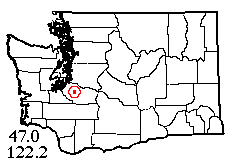 |
![]() 6 V 2006: Scarab Fred Austin, on an errand to Puyallup, dropped me off
at a gated logging road near Orting and I hiked into a parcel of state forest
land with a pond, wetland, fir and alder forests, and an 8-year-old clearcut.
The clearcut, never planted with trees, is about 2/3 overgrown with Scots broom
(see album), but the remaining third has developed
a plant community resembling heath-shrub prairie, and already has some interesting
spiders like Oxyopes (lynx spiders) and a prairie jumping spider species.
I also saw bear scat! Two wolf spider species were briefly active during a sun
break. After sampling this habitat, I located a trail going north into the forest
and down to the pond, originally impounded by an earth dam which is partly breached.
A 4-wheeler club promptly appeared and happily splashed across the gap before
heading up a broom-covered slope to the north. I got good samples here from
litter, moss, understory, rocks and boards before heading back to the south
edge of the clearing, where a tall growth of salal provided another good habitat.
Several other interesting species were taken, including the attractive little
Walckenaeria auranticeps and, by the pond, the primitive Hexura
which usually lives in less disturbed places. Total, 33 species in 5 hours.
6 V 2006: Scarab Fred Austin, on an errand to Puyallup, dropped me off
at a gated logging road near Orting and I hiked into a parcel of state forest
land with a pond, wetland, fir and alder forests, and an 8-year-old clearcut.
The clearcut, never planted with trees, is about 2/3 overgrown with Scots broom
(see album), but the remaining third has developed
a plant community resembling heath-shrub prairie, and already has some interesting
spiders like Oxyopes (lynx spiders) and a prairie jumping spider species.
I also saw bear scat! Two wolf spider species were briefly active during a sun
break. After sampling this habitat, I located a trail going north into the forest
and down to the pond, originally impounded by an earth dam which is partly breached.
A 4-wheeler club promptly appeared and happily splashed across the gap before
heading up a broom-covered slope to the north. I got good samples here from
litter, moss, understory, rocks and boards before heading back to the south
edge of the clearing, where a tall growth of salal provided another good habitat.
Several other interesting species were taken, including the attractive little
Walckenaeria auranticeps and, by the pond, the primitive Hexura
which usually lives in less disturbed places. Total, 33 species in 5 hours.
When I rejoined
Scarab Austin, he felt like driving some more, so we did a tour of the Buckley,
Wilkeson and Carbonado areas locating some potential sites for further trips.
My maps showed no
name for the place I'd collected; so I did some further research, coming up
with the name Horse Haven Creek and the appalling news that this 320-acre parcel
of state forest land - the only large piece of public open space in this vicinity
- is being traded by the Department of Natural Resources (our Public Servants)
to a developer in exchange for another natural resource - a Walgreens store!
If this sounds too outrageous to be believed, see this news story; you can also download PDF minutes of the January and February 2006 Board of Natural Resources meetings, as evidence.
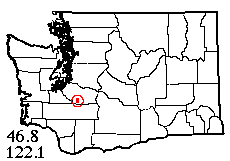 |
![]() 11 V 2006: We had only a 6-hour window (including driving) for volunteer
Cheryl Tseo's first collecting trip, so I picked an area east of Eatonville
where I already had a 12-species sample from a trip in 1980 to what was then
state forest land but is now in a private tree farm. I'd picked several possible
sites in the area. Good thing, because all but one proved to be on the wrong
side of a new gate. But all's well, the one outside the gate was a lovely semi-marshy
meadow, once part of a now abandoned farm, but in reasonably natural condition
- and, to my surprise, surrounded by a forest largely of Sitka spruce, not at
all common this far from the ocean.
11 V 2006: We had only a 6-hour window (including driving) for volunteer
Cheryl Tseo's first collecting trip, so I picked an area east of Eatonville
where I already had a 12-species sample from a trip in 1980 to what was then
state forest land but is now in a private tree farm. I'd picked several possible
sites in the area. Good thing, because all but one proved to be on the wrong
side of a new gate. But all's well, the one outside the gate was a lovely semi-marshy
meadow, once part of a now abandoned farm, but in reasonably natural condition
- and, to my surprise, surrounded by a forest largely of Sitka spruce, not at
all common this far from the ocean.
Three wolf spider
species were racing about the meadow during sun breaks, and two people sweeping
produced 10 field-layer species in an hour, including a large series of an uncommon,
shield-backed Ceraticelus species. We also found the introduced crab
spider Xysticus cristatus is still extending its range (first taken in
the Puget Sound area in 1993). Conifer foliage (largely spruce) was reasonably
productive. After a lunch break, we moved into the forest fringe and collected
from litter, moss and rotten wood, each yielding a few characteristic species.
In the 3 hours before we had to leave we got 26 species, bringing the area total
to 32. So far, I haven't been disappointed once in the collecting sites located
through the new online aerial and satellite photo resources.
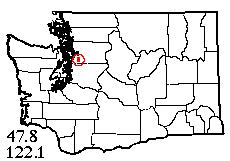 |
![]() 15 V 2006: I had 10 spider species records from the area which is now
the city of Mill Creek - 20 years ago much of it was still open country. Now,
the only decent habitat I could find near a bus route was Heron Park, very small
as suburban parks go but containing seemingly natural forest and wetland. To
get there from the Seattle bus I walked past endless housing developments and
a golf course. When I reached the park I followed a "hiking trail"
just inside the north and east edges. You could tell which houses had ivy in
their yards, because the adjacent park trees were enshrouded. Holly was escaping
from the same yards. There had been some effort to restore habitat, but you
only had to get out of sight of the trail to get into Himalayan blackberry.
A nice-looking willow swamp was being invaded by cutleaf blackberry. And the
pond was so choked with purple
loosestrife that at first I wondered if it was a bog, but no such luck!
15 V 2006: I had 10 spider species records from the area which is now
the city of Mill Creek - 20 years ago much of it was still open country. Now,
the only decent habitat I could find near a bus route was Heron Park, very small
as suburban parks go but containing seemingly natural forest and wetland. To
get there from the Seattle bus I walked past endless housing developments and
a golf course. When I reached the park I followed a "hiking trail"
just inside the north and east edges. You could tell which houses had ivy in
their yards, because the adjacent park trees were enshrouded. Holly was escaping
from the same yards. There had been some effort to restore habitat, but you
only had to get out of sight of the trail to get into Himalayan blackberry.
A nice-looking willow swamp was being invaded by cutleaf blackberry. And the
pond was so choked with purple
loosestrife that at first I wondered if it was a bog, but no such luck!
Be that as it may,
I sifted leaf litter which was clearly past its prime, beat understory and conifer
foliage, found some spider-bearing conifer litter, and took a number of specimens
from under the railings of the pond observation platform. I thought to get some
house spider species from the picnic shelter area, but though the structure
had plenty of old webs, there wasn't one live spider - as if a pesticidal maniac
had been at work. Despite all obstacles I managed to get 22 species, making
29 with the older records. Six of the spider species and the one harvestman
taken were introduced. Is it futile to try to keep a natural place in the midst
of thousands of unnatural yards and gardens?
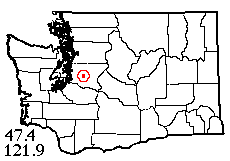 |
![]() 19 V 2006: My weekend plans derailed by predicted rain, I scheduled a
bus trip to another suburban greenbelt on the last dry day. This one, again
found by satellite photo, was 2 miles east of Maple Valley (which was as close
as the bus came). The long walk in sultry weather was made less pleasant by
lots of trucks on the road and nearly every undeveloped lot I passed swallowed
up by blackberries, giving me little hope for the site I was headed for. But
when I got there it was a pleasant surprise, with mostly natural vegetation
plus ponds and marshes. There was something decidedly odd about this tract.
With well-groomed rural residential land on both sides, this small woodland
contained a complex network of old dirt roads, some grassy but others clearly
in use. Here and there were derelict cars, a derelict camper, even a derelict
doghouse, plus remains of a squatters' camp, rotting plank bridges and a mini-dock
on one of the ponds... as if a few acres of Appalachia were plunked down in
Maple Valley.
19 V 2006: My weekend plans derailed by predicted rain, I scheduled a
bus trip to another suburban greenbelt on the last dry day. This one, again
found by satellite photo, was 2 miles east of Maple Valley (which was as close
as the bus came). The long walk in sultry weather was made less pleasant by
lots of trucks on the road and nearly every undeveloped lot I passed swallowed
up by blackberries, giving me little hope for the site I was headed for. But
when I got there it was a pleasant surprise, with mostly natural vegetation
plus ponds and marshes. There was something decidedly odd about this tract.
With well-groomed rural residential land on both sides, this small woodland
contained a complex network of old dirt roads, some grassy but others clearly
in use. Here and there were derelict cars, a derelict camper, even a derelict
doghouse, plus remains of a squatters' camp, rotting plank bridges and a mini-dock
on one of the ponds... as if a few acres of Appalachia were plunked down in
Maple Valley.
After a little wolf-spider
sampling I settled down to sweeping the rich forest understory before the somewhat
threatening clouds had a chance to make it too wet. Wise move - I was just finished
when the rain came a day ahead of schedule. So I set up shop under nature's
umbrella, a red cedar tree, and stayed almost dry for the next 2 hours while
I sifted moss and maple litter. Some collecting methods had to be skipped due
to the rain but I still had 23 species when I headed back for the long bus ride
home. This tract probably won't keep its present habitat quality long, since
all the expected invasive plants have little colonies throughout the area, just
waiting their chance to take over.
 |
![]() 3 VI 2006: The state Department of Wildlife has instituted an annual
BioBlitz (marathon all-taxon sampling frenzy) to gain baseline biological info
on managed greenbelts in the south Puget Sound area. This year's event (my first)
was along the White River between Auburn and Buckley. Having bailed out of the
first day due to torrential rain (not conducive to spider collecting), I showed
up at blitz HQ (a grange building and large tent) with doughty volunteer Kate
Turner and arranged to visit a meadow that appeared promising for spiders. Blitz
organizer Michelle Tirhi thought she'd smoothed relations with all local landowners.
Wouldn't you know I'd pick the only exception! Chased away from our assigned
spot, we ended up approaching it circuitously by a long walk down a road whose
gate was supposed to be open. But the site ended up being worth it. Despite
lots of Scots broom in the grassland, the spider fauna was reasonably rich and
included uncommon species of Cicurina, Ceratinella and Philodromus.
Don't know how long this site will last, though - Himalayan blackberry, that
arch-destroyer, is lurking even in the shaded understory.
3 VI 2006: The state Department of Wildlife has instituted an annual
BioBlitz (marathon all-taxon sampling frenzy) to gain baseline biological info
on managed greenbelts in the south Puget Sound area. This year's event (my first)
was along the White River between Auburn and Buckley. Having bailed out of the
first day due to torrential rain (not conducive to spider collecting), I showed
up at blitz HQ (a grange building and large tent) with doughty volunteer Kate
Turner and arranged to visit a meadow that appeared promising for spiders. Blitz
organizer Michelle Tirhi thought she'd smoothed relations with all local landowners.
Wouldn't you know I'd pick the only exception! Chased away from our assigned
spot, we ended up approaching it circuitously by a long walk down a road whose
gate was supposed to be open. But the site ended up being worth it. Despite
lots of Scots broom in the grassland, the spider fauna was reasonably rich and
included uncommon species of Cicurina, Ceratinella and Philodromus.
Don't know how long this site will last, though - Himalayan blackberry, that
arch-destroyer, is lurking even in the shaded understory.
Along the river
bank we got 2 additional wolf spider species and some males of the introduced
zebra jumping spider Salticus scenicus roving the gravel, then headed
back up the road out of the canyon - and I abruptly ran out of energy. I plodded
to the top at a snail's pace, wondering at how out of shape I seemed to be.
I had a little cough, indicating (I thought) some kind of virus, but that could
hardly explain this. Next day I was too tired even to look at specimens. Two
days later I was in the E.R. with what turned out to be pneumonia! It descended
without warning literally out of a clear blue sky. Beware, it could happen to
you too... See this link for more on the 2006
White River BioBlitz.
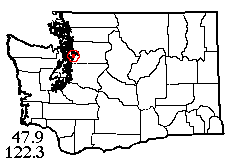 |
![]() 28 VI 2006: Finally over my bout of pneumonia, I thought I'd try a fairly
simple local collecting trip to get back in the swim. My goal was the "Big
Gulch Open Space," a ravine system saved from an otherwise suburbanized
section of the city of Mukilteo. Using aerial and satellite photos, I'd selected
7 spots where there might be pedestrian access to the area - maybe even a trail!
The first one did give access, but no trail, and penetrability of the ravine
was limited by dense nettle stands. So I wasted about 2 hours and much energy
hiking all over the housing-tract roads to the other 6 spots, which gave no
access at all. Back to square one, I found that the first area (a pure maple
forest with nearly closed canopy) actually had quite natural vegetation despite
the proximity of houses. The understory was lush, leaf litter was available,
a huge old-growth stump yielded some rotten-wood spiders, and a few other microhabitats
existed. But due to the shortness of time, I only got 17 species. This high-quality
tract also contained banana slugs, a western red-backed salamander, a raccoon
climbing a tree in daylight, and lots of mountain-beaver tunnels high on the
ravine sides. And no, I didn't escape without nettle stings.
28 VI 2006: Finally over my bout of pneumonia, I thought I'd try a fairly
simple local collecting trip to get back in the swim. My goal was the "Big
Gulch Open Space," a ravine system saved from an otherwise suburbanized
section of the city of Mukilteo. Using aerial and satellite photos, I'd selected
7 spots where there might be pedestrian access to the area - maybe even a trail!
The first one did give access, but no trail, and penetrability of the ravine
was limited by dense nettle stands. So I wasted about 2 hours and much energy
hiking all over the housing-tract roads to the other 6 spots, which gave no
access at all. Back to square one, I found that the first area (a pure maple
forest with nearly closed canopy) actually had quite natural vegetation despite
the proximity of houses. The understory was lush, leaf litter was available,
a huge old-growth stump yielded some rotten-wood spiders, and a few other microhabitats
existed. But due to the shortness of time, I only got 17 species. This high-quality
tract also contained banana slugs, a western red-backed salamander, a raccoon
climbing a tree in daylight, and lots of mountain-beaver tunnels high on the
ravine sides. And no, I didn't escape without nettle stings.
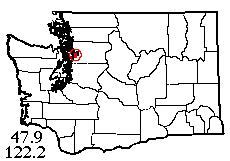 |
![]() 30 VI 2006: After one day's rest, with the weather still warm (perhaps
a bit too much so), I returned to Mukilteo to supplement the previous sample
and also collect in an adjacent area, squeezing the last drop out of the month
of June. I'd thought I could find some sort of habitat west of the Mukilteo
Speedway, but where I got off the bus there seemed no way to get west of the
blasted highway - so I ended by taking my supplementary sample from the grass/dandelion
roadside verge with weekday traffic zooming by 6 feet away. Surprisingly, 4
grassland species (one of them actually native) were taken from this unlikely
source, making a barely adequate 21-species collection from the "7923"
grid area.
30 VI 2006: After one day's rest, with the weather still warm (perhaps
a bit too much so), I returned to Mukilteo to supplement the previous sample
and also collect in an adjacent area, squeezing the last drop out of the month
of June. I'd thought I could find some sort of habitat west of the Mukilteo
Speedway, but where I got off the bus there seemed no way to get west of the
blasted highway - so I ended by taking my supplementary sample from the grass/dandelion
roadside verge with weekday traffic zooming by 6 feet away. Surprisingly, 4
grassland species (one of them actually native) were taken from this unlikely
source, making a barely adequate 21-species collection from the "7923"
grid area.
My next goal was
half a mile to the east, an area identified as a public park (Highland Memorial
Park) in two online resources, right on the Mukilteo-Everett border. On reaching
the site I found no signage at all (not even "keep out"), but an old
paved roadway with a rusty cable gate blocking car access led into the area,
which proved to be entirely undeveloped and a truly lovely spot. Large tall-grass
fields are surrounded by Douglas-fir and alder forests, with only a couple of
areas badly invaded by blackberry. To avoid the early afternoon heat I started
operations in the forest fringe, and soon found a well-hidden little pond in
the woods. Leaf litter was essentially absent, but understory, fir foliage and
objects on the ground produced a spider fauna significantly different from what
I'd found two days before and not so very far away. Later, the grassy fields
proved extremely productive (there was even one wolf spider species still active),
and an odd structure of concrete, blocks and culvert in the middle of a field
even contained some house spider species. Until some hikers passed by late in
the day, the only sounds suggestive of humans were airplanes from nearby Paine
Field and ferry horns. I got 29 species here in 3.5 hours. Hope someone doesn't
develop the place into a soccer field!
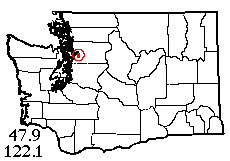 |
![]() 6 VII 2006: With a forecast of "partly cloudy," my friend Della
packed up one of her justly famed picnic lunches and 2 bus agencies soon brought
us to Rotary Park on the Snohomish River, just across the freeway from downtown
Everett. The area is not as urbanized as you might expect, but Himalayan blackberry
has run rampant. I found some tall grass, still sweepable, along the river bank
that yielded the best species of the day, including three species of the long-bodied
Tetragnatha orbweavers (two of them distinctly rare) and a microspider
I didn't recognize. I also managed to lose my sunglasses (hardly needed under
the thickening clouds) in a nearby drying marsh of very tall sedge. We followed
a bike trail to a larger area of the park where I took 3 species from the restroom
building but only one turned out identifiable. Every bit of woodland we passed
was blocked from access and partly penetrated by blackberries, and other habitats
were scarce, so I left Della to relax while I tried an undeveloped "open
space" across the road.
6 VII 2006: With a forecast of "partly cloudy," my friend Della
packed up one of her justly famed picnic lunches and 2 bus agencies soon brought
us to Rotary Park on the Snohomish River, just across the freeway from downtown
Everett. The area is not as urbanized as you might expect, but Himalayan blackberry
has run rampant. I found some tall grass, still sweepable, along the river bank
that yielded the best species of the day, including three species of the long-bodied
Tetragnatha orbweavers (two of them distinctly rare) and a microspider
I didn't recognize. I also managed to lose my sunglasses (hardly needed under
the thickening clouds) in a nearby drying marsh of very tall sedge. We followed
a bike trail to a larger area of the park where I took 3 species from the restroom
building but only one turned out identifiable. Every bit of woodland we passed
was blocked from access and partly penetrated by blackberries, and other habitats
were scarce, so I left Della to relax while I tried an undeveloped "open
space" across the road.
That area (see
album) should have had a large grassy field, but the only actual grass was
along the road; the rest was an extreme case of blackberry jungle, taller than
my head, through which someone has maintained a reasonably passable path. Curious,
I followed this path all the way across and through a small willow patch (impenetrable),
ending at a railroad trestle, just the spot to shelter old-fashioned hobos,
but untenanted at the moment. The only place to collect was back by the road,
where one maple tree had escaped the blackberries and produced some spider-bearing
leaf litter. As I sifted this, and the light mist gradually increased toward
sprinkle, drizzle, and rain, a chap passed me, headed for the trestle! With
a wet net, further collecting soon became impossible, and bad luck plus blackberries
limited the day's catch to a frustrating 19 species.
16 VII 2006:
8 days later, I returned to North Everett determined to get several more species
and complete my sample. The express bus from Seattle goes to Everett Station,
shared with trains, and a short walk down the tracks brought me to a run-down
industrial area with weedy fields that seemed miles from the downtown buildings
a few blocks away. Sweeping added only one species to the former sample, but
rubble and junk by the railroad tracks sheltered all three local Tegenaria
species plus an unusual Linyphantes, and Neriene digna had its
web in a discarded baby stroller, bringing the total to 25 species. If at first
you don't succeed...
26 VII 2006:
Serendipity! On the North Everett trip, I caught a small, unfamiliar, immature
jumping spider hopping about on huge concrete blocks in the "back yard"
of some industrial property. Ten days later it matured, and turned out to be
Sitticus pubescens - first West Coast record of this European species.
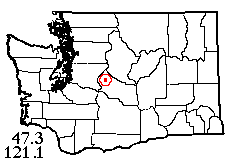 |
![]() 8 VII 2006: I'd been planning a trip with Fred Austin for several days;
originally both his sons were to participate but their plans changed and it
was just us two. My goal was an area around French Cabin Mountain (west of Cle
Elum Reservoir) that I'd visited briefly in 1977 but scarcely had a chance to
collect. I hoped this time to reach a parkland area near French Cabin Basin,
but the overgrown road proved too narrow for Fred's car, and we settled for
a second growth true-fir stand on the West Fork of French Cabin Creek. It was
an attractive area, with rather varied vegetation, rock outcrops, and wildflowers.
8 VII 2006: I'd been planning a trip with Fred Austin for several days;
originally both his sons were to participate but their plans changed and it
was just us two. My goal was an area around French Cabin Mountain (west of Cle
Elum Reservoir) that I'd visited briefly in 1977 but scarcely had a chance to
collect. I hoped this time to reach a parkland area near French Cabin Basin,
but the overgrown road proved too narrow for Fred's car, and we settled for
a second growth true-fir stand on the West Fork of French Cabin Creek. It was
an attractive area, with rather varied vegetation, rock outcrops, and wildflowers.
Mosquitos and deer
flies were conspicuous elements of the fauna even in the heat of the day,
but spiders were surprisingly hard to find. Most of the species taken were from
vegetation. All the wolf spiders were the common Pardosa mackenziana.
Leaf litter in the alder thicket around the creek produced only three species,
and a promising looking remnant old-growth tree trunk had lots of webs and retreats
but no spiders at all. All the mature spiders under rocks were the common Zelotes
fratris, but fortunately a juvenile kept for rearing turned out to be the
rare Z. tuobus. The total for 6 hours of hard work (and a blood donation
to the Order Diptera) was 24 species.
 |
![]() 12 VII 2006: Devon Lopetrone, visiting arachnologist from California,
is studying the "fishing spiders" of the genus Dolomedes and
wanted a live Washington specimen for research. I'd told him "lotsa luck"
- I'd only collected this rarity 4 times in 35 years. It lives in totally undisturbed
ponds with emergent vegetation, and blithely skates out over the water while
hapless collectors are tottering on hummocks or wallowing in the mud. On the
last day of Devon's visit, rain was predicted but eastern Washington was supposed
to be only partly cloudy, so I suggested we try some ponds near South Cle Elum
shown on aerial photos.
12 VII 2006: Devon Lopetrone, visiting arachnologist from California,
is studying the "fishing spiders" of the genus Dolomedes and
wanted a live Washington specimen for research. I'd told him "lotsa luck"
- I'd only collected this rarity 4 times in 35 years. It lives in totally undisturbed
ponds with emergent vegetation, and blithely skates out over the water while
hapless collectors are tottering on hummocks or wallowing in the mud. On the
last day of Devon's visit, rain was predicted but eastern Washington was supposed
to be only partly cloudy, so I suggested we try some ponds near South Cle Elum
shown on aerial photos.
The first pond could
only be accessed at one point, and all the good-looking habitat was on the other
side, so we moved on to the John
Wayne Trail (a former railroad that crosses much of the state, east to west)
and hiked about a mile west of town to where two good-sized ponds showed on
maps and aerial photos. Unhappily, the one thing these resources don't show
is the "no trespassing" signs! We were able to access the area across
the trail from the unfriendly signs, and here Devon found a nice little pond
filling a former gravel pit. It even had three shoreline wolf spider species,
but no Dolomedes. I had a partial, 11-species sample from this area and
only 3 hours collecting from leaf litter, rocks, wood and a small junkyard served
to upgrade it to 27 - including some nice uncommon species. The vegetation was
still too wet from a brief rain shower (even though followed by sun), so I suggested
we move on to other ponds. One near Cle Elum was gone, paved over for industry.
After that, we tried Bullfrog Pond near Roslyn, one of the highest quality examples
I knew of nearby. Here, dense vegetation and water channels only allowed access
at one point, where no Dolomedes could be found, but it's a beautiful
spot and the resident beaver made a cameo appearance. On the way home, I thought
we'd check out some ponds near Lake Keechelus but we were back into the rain
before then... Oh well, I told him they were rare!
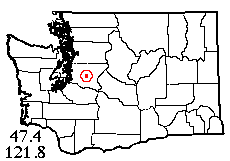 |
![]() 18 VII 2006: While the days were still long, I wanted to fulfill a plan
that promised to take a long day indeed. One of the areas with an old partial
spider sample could be reached by hiking up an old logging road near the old
Snoqualmie Winery. The road is now part of the Rattlesnake
Mountain Trail system. Unfortunately the trailhead is well over 2 road miles
from the nearest bus stop. To reach the area I wanted to collect in (near a
wetland on the summit plateau) would be a 5.3 mile walk each way with a 1500
foot elevation gain. Well, I did it. Only made one major wrong turn, from which
my GPS rescued me when it finally located some satellites. As I write (next
day) I'm a bit footsore but feeling pretty good about recovering my full health.
18 VII 2006: While the days were still long, I wanted to fulfill a plan
that promised to take a long day indeed. One of the areas with an old partial
spider sample could be reached by hiking up an old logging road near the old
Snoqualmie Winery. The road is now part of the Rattlesnake
Mountain Trail system. Unfortunately the trailhead is well over 2 road miles
from the nearest bus stop. To reach the area I wanted to collect in (near a
wetland on the summit plateau) would be a 5.3 mile walk each way with a 1500
foot elevation gain. Well, I did it. Only made one major wrong turn, from which
my GPS rescued me when it finally located some satellites. As I write (next
day) I'm a bit footsore but feeling pretty good about recovering my full health.
The trail and gated-road
system was beautifully vegetated, with only minor amounts of invasive plants,
and completely deserted on this partly-cloudy summer weekday. I passed through
miles of mixed lowland seral forest, with pleasantly shady stretches and sunny,
grassy roadside verges, and only encountered about 3 deer flies. The powerline
clearing at the edge of the summit ridge was incredibly lush, green and floral.
This led past a viewpoint to the side-road system I wanted, which took me through
recovering clearcuts (with dense native berry shrubs). I love fresh salmonberries!
But wait, where was my side road to the wetland? It had been so effectively
obliterated with slash, rocks and soil piles that only the tank traps gave it
away. Eight years ago, it showed on an aerial photo as a road like any other
road, but now it's a rich habitat for all kinds of plants and one of the better
sites I've found for under-stone spider fauna west of the Cascades. Sometimes,
restoration works! Two wolf spider species were running, and there were spiders
on the field and roadside foliage (sadly, mostly the introduced Enoplognatha
ovata); back in the clearcut jungle, Douglas-fir foliage produced some more
native spiders. Having to head back down to catch the last bus home, I stopped
at a big maple tree for some litter and moss spiders (only one species of each
was mature), just when the mosquitoes were starting to come out! I successfully
upgraded my former sample, got some interesting records, and had a day of healing
sylvan solitude - well worth a sore foot. And yes, I saw several garter snakes
on Rattlesnake Mountain.
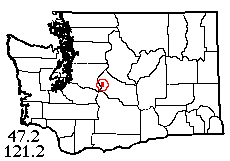 |
![]() 29 VII 2006: My friend Markku Savela, Finnish nature photographer (see
his web site),
was in Seattle again on his quasi-annual visit. Because the season was late,
we picked a high elevation site for our joint field trip: the summit ridge of
Cabin Mountain (4700' elevation), SE of Snoqualmie Pass. Markku's friend Valentina
Anderson drove. Thanks to good maps, the maze of logging roads was negotiated
without one wrong turn and we reached our destination in good time. The north
side of the summit ridge had been logged (perhaps 20 years ago), but seems to
have been subalpine parkland since the stumps are pretty sparse. The area is
coming back the same way, with only a few young trees growing out of the shrub
meadow, dominated by huckleberry (some were ripe, yum) with smaller bare or
grassy spots. The south side of the ridge was still pristine, but very steep.
Spring wildflowers were over, but an array of inconspicuous plants was still
blooming among the shrubs and true fir groves. Invasive non-native plants (and,
more surprising still, non-native spiders) were absent.
29 VII 2006: My friend Markku Savela, Finnish nature photographer (see
his web site),
was in Seattle again on his quasi-annual visit. Because the season was late,
we picked a high elevation site for our joint field trip: the summit ridge of
Cabin Mountain (4700' elevation), SE of Snoqualmie Pass. Markku's friend Valentina
Anderson drove. Thanks to good maps, the maze of logging roads was negotiated
without one wrong turn and we reached our destination in good time. The north
side of the summit ridge had been logged (perhaps 20 years ago), but seems to
have been subalpine parkland since the stumps are pretty sparse. The area is
coming back the same way, with only a few young trees growing out of the shrub
meadow, dominated by huckleberry (some were ripe, yum) with smaller bare or
grassy spots. The south side of the ridge was still pristine, but very steep.
Spring wildflowers were over, but an array of inconspicuous plants was still
blooming among the shrubs and true fir groves. Invasive non-native plants (and,
more surprising still, non-native spiders) were absent.
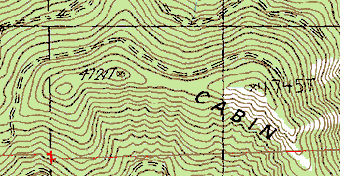 |
The spider fauna of the meadow and conifer foliage was a bit sparse, but interesting, including a pretty Theridion I didn't recognize. Pardosa wolf spiders were still active in the clearing, and gnaphosids and jumping spiders were found under dead wood; a female of the uncommon Habronattus jucundus led me quite a merry chase, but finally hopped into my net. I found an impressively large wolf spider burrow, which I excavated with high hopes - to find only a parasitic wasp's cocoon. Deep needle duff under the true firs on the south slope produced a diverse group of microspiders. This undersampled area was upgraded to 25 species, and Markku got some nice photos too.
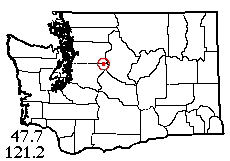 |
![]() 11 VIII 2006: Since spring, I've been trying to coordinate with Louise
Wynn, student interested in spiders at a Washington State U. branch campus,
for a collecting trip. It finally happened, and as an added bonus Markku was
able to go along. In late summer, only the high country is good for spiders,
so we drove to the Johnson
Ridge Trail north of Skykomish, intending to hike to a subalpine meadow
near the top of Sunrise Mountain. The first part of the trail (through a regenerating
clearcut) is a bit steep, but scenic. Stops for photo ops helped us catch our
breath. Once into the old-growth western hemlock, hiking was a breeze, and pleasantly
cool under the low clouds. Soon we were at a narrow heather meadow that I thought
was our goal, and Louise and I stopped to collect while Markku forged on in
search of more diverse flowers. He soon discovered that we hadn't been at the
summit (the trail continued upwards), and did find a better meadow for flowers
near the actual top.
11 VIII 2006: Since spring, I've been trying to coordinate with Louise
Wynn, student interested in spiders at a Washington State U. branch campus,
for a collecting trip. It finally happened, and as an added bonus Markku was
able to go along. In late summer, only the high country is good for spiders,
so we drove to the Johnson
Ridge Trail north of Skykomish, intending to hike to a subalpine meadow
near the top of Sunrise Mountain. The first part of the trail (through a regenerating
clearcut) is a bit steep, but scenic. Stops for photo ops helped us catch our
breath. Once into the old-growth western hemlock, hiking was a breeze, and pleasantly
cool under the low clouds. Soon we were at a narrow heather meadow that I thought
was our goal, and Louise and I stopped to collect while Markku forged on in
search of more diverse flowers. He soon discovered that we hadn't been at the
summit (the trail continued upwards), and did find a better meadow for flowers
near the actual top.
Meanwhile, we who
stayed at the 4640' level had nothing to complain of. Our meadow was the point
where western hemlock gave way to mountain hemlock, and the conifer foliage
had quite a rich spider fauna for the time of year. The conifer-needle litter
on the old-growth forest floor likewise gave us a diverse set of microspiders,
and several more were added from dead wood and bark at the foot of a snag. The
forest understory (mostly Vaccinium) produced little, but the huckleberries
were tasty. 19 species (including 2 new or rare) had been taken here by the
time Louise (with a long drive ahead) called to see if Markku was in earshot
yet - he answered from behind us! We'd been so intent on the good collecting,
he'd walked right by. Up to now, no Pardosa had been seen, but one had
the poor judgment to cross my path on the way down. A bag of alder litter from
the trailhead completed our day's work. A final total will have to await the
rearing of the 3 live immatures I brought back, but will probably exceed 30
species - excellent for an August trip.
 |
![]() 22 X 2006: The plan was to take the bus to the town of Snohomish and
hike south, to where it appeared I could access a lovely-looking habitat in
an oxbow of the Pilchuck River via some railroad tracks. What the aerial photos
didn't make clear was that the tracks were 30 feet over my head! Scratch that
idea, and all other possible habitats in the vicinity were completely overgrown
with blackberry. So- back through Snohomish to the start of the Centennial
Trail (part of the rails to trails program) which I'd just been reading
about. Almost 3 footsore miles later on the paved "trail," a powerline
right-of-way (only 60% blackberried) gave me a habitat where I might make a
stab at collecting.
22 X 2006: The plan was to take the bus to the town of Snohomish and
hike south, to where it appeared I could access a lovely-looking habitat in
an oxbow of the Pilchuck River via some railroad tracks. What the aerial photos
didn't make clear was that the tracks were 30 feet over my head! Scratch that
idea, and all other possible habitats in the vicinity were completely overgrown
with blackberry. So- back through Snohomish to the start of the Centennial
Trail (part of the rails to trails program) which I'd just been reading
about. Almost 3 footsore miles later on the paved "trail," a powerline
right-of-way (only 60% blackberried) gave me a habitat where I might make a
stab at collecting.
I say "stab"
advisedly. Even where the site wasn't a sea of blackberries, there were just
enough individual vines to seriously hamper me and everything I tried to do.
Anyone who knows me would have been amazed at the amount of swearing I did this
trip. However, I did manage to get collections from maple-cottonwood leaf litter,
moss, tall grass, and an area of quasi-natural meadow foliage, before descending
into the ravine to collect along the Pilchuck River shoreline. At one point
I hopped back from a gravel bar to the grassy bank - at a spot where the grass
had no bank under it! Back at the bus line, the number 271 was 20 minutes late
which made me miss my connection and sit around Everett Station for an extra
hour. On the plus side, it was an absolutely gorgeous day with the fall colors
just getting well under way (see album). And with
all the things that went wrong, I still got 28 species (though with a high proportion
of non-natives); the very last one, a decidedly interesting Poeciloneta
from moss beside the river.
 |
![]() 28 X 2006: Continuing to prospect for collecting sites on remote bus
routes, I found a likely spot in the Stillaguamish River delta. Maps call the
place Hat Slough. Come to find out, though, the maps are wrong - it's named
for an early settler, James Hatt (see this
article). I wasted an hour taking my last bus in the wrong direction, but
arrived at my site just after 1pm and soon found the Department of Wildlife
public access, maintained by the stewardship of the Stillaguamish Indian Tribe. The tribe deserves big kudos for chopping down most of the
blackberry, restoring spider habitat in the riparian woodland. Alder litter
and understory foliage were fairly productive, moss produced little, and several
species (as usual) were found in and on the site outhouse.
28 X 2006: Continuing to prospect for collecting sites on remote bus
routes, I found a likely spot in the Stillaguamish River delta. Maps call the
place Hat Slough. Come to find out, though, the maps are wrong - it's named
for an early settler, James Hatt (see this
article). I wasted an hour taking my last bus in the wrong direction, but
arrived at my site just after 1pm and soon found the Department of Wildlife
public access, maintained by the stewardship of the Stillaguamish Indian Tribe. The tribe deserves big kudos for chopping down most of the
blackberry, restoring spider habitat in the riparian woodland. Alder litter
and understory foliage were fairly productive, moss produced little, and several
species (as usual) were found in and on the site outhouse.
An area where the
highway had been straightened (and the old road removed) had grown up in quasi-natural
riparian meadow, though some blackberry-removal work is needed here. Orbweavers
- including one of the farthest north records of Argiope trifasciata
(see album) in western Washington - and others
were common in the tall grass. On the south side of the slough, a grove of Douglas-firs
in the riparian meadow looked promising - the land was private but the owner,
as usual, friendly - and several linyphiid species were incredibly abundant
on the fir foliage, including the vivid red-and-black, 2.5-mm Walckenaeria
auranticeps (see album). I sifted some fir
litter in the last daylight, then waited for my homeward bus as the sun set
across the delta. Total catch was a very good 35 species.
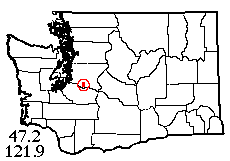 |
![]() 1 XI 2006: I'd long been interested in Hanging Gardens State Park, an
undeveloped tract on the Green River. Trouble is, the only official access is
by floating down the river! This could make winter visits slightly uncomfortable.
But using aerial and satellite photos, I thought I'd found a dirt track leading
into the area from the Black Diamond-Enumclaw Highway. On the last dry day before
a long spell of predicted rain, I got off the bus (last of 4 to get me from
home to this remote spot) and headed up the track, thinking this might actually
work. But in a half mile, a barrier and fence announced "Black
Diamond Gun Club - Members only." So, I backtracked to a blocked, unposted
side track I'd noticed. I wasn't able to go far because of blackberries spilling
onto the road from a high bank (see album) that
was positively a mass of them! However, a few feet in from the other side of
the road, the young forest became pleasantly natural.
1 XI 2006: I'd long been interested in Hanging Gardens State Park, an
undeveloped tract on the Green River. Trouble is, the only official access is
by floating down the river! This could make winter visits slightly uncomfortable.
But using aerial and satellite photos, I thought I'd found a dirt track leading
into the area from the Black Diamond-Enumclaw Highway. On the last dry day before
a long spell of predicted rain, I got off the bus (last of 4 to get me from
home to this remote spot) and headed up the track, thinking this might actually
work. But in a half mile, a barrier and fence announced "Black
Diamond Gun Club - Members only." So, I backtracked to a blocked, unposted
side track I'd noticed. I wasn't able to go far because of blackberries spilling
onto the road from a high bank (see album) that
was positively a mass of them! However, a few feet in from the other side of
the road, the young forest became pleasantly natural.
This forest had
an odd mixture of alders, exceptionally tall and treelike vine maples, and an
occasional cottonwood, bigleaf maple or conifer. The leaf litter was outstandingly
rich; I got 20 spider species by sifting in not much over an hour. It's a good
thing I did that first, because the other habitats (grass, moss, understory
foliage, rotten stump) that I tried were much less productive. The nearby gun
club provided sound effects. I left this site before dusk because I wanted to
briefly visit a wetland back by the highway. Alas, it was unapproachable - completely
surrounded by blackberries! So I beat the foliage of some planted Douglas firs
and swept some grass at the intersection before starting the highway hike back
to Black Diamond and the bus home. Total for the day was 28 species, making
33 with prior records from the area, including some very attractive spiders
(see album) and all three of the species I wanted
for DNA samples for a colleague's study - very worthwhile.
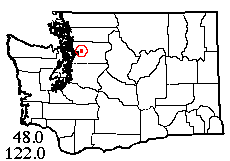 |
![]() 14 XI 2006: A non-rainy day was predicted, first in 2 weeks (and maybe
last for a while), so I thought I'd best take advantage with a bus trip to forested
parks in the suburban city of Lake Stevens. Catherine Creek Park is a mature
Douglas-fir/cedar forest with some impressive trees and kept clear of invasive
plants, but most of it is groomed to some extent to provide for its main use,
a sylvan "disk golf course." Click
here if you want more information on this game, invented by a chap named
"Steady Ed" and played on more than 2000 designated courses - I kid
you not! As I approached, it was clear that it had rained here more recently
than in Seattle. However, things were not too soggy under the dense canopy and
I got 7 spider species from understory foliage - largely sword ferns, bushier
plants having been removed to make way for flying disks! I found no spiders
in the cedar litter, and no deciduous litter worthy of the name - the alder
woods along adjacent Catherine Creek were blackberried to death; so I tried
for a litter sample in adjacent, ungroomed Centennial Woods Park (6.5 acres).
Here, I found plenty of invasive plants, especially ivy, but blackberry gaining
a foothold in parts - and rain began to sprinkle.
14 XI 2006: A non-rainy day was predicted, first in 2 weeks (and maybe
last for a while), so I thought I'd best take advantage with a bus trip to forested
parks in the suburban city of Lake Stevens. Catherine Creek Park is a mature
Douglas-fir/cedar forest with some impressive trees and kept clear of invasive
plants, but most of it is groomed to some extent to provide for its main use,
a sylvan "disk golf course." Click
here if you want more information on this game, invented by a chap named
"Steady Ed" and played on more than 2000 designated courses - I kid
you not! As I approached, it was clear that it had rained here more recently
than in Seattle. However, things were not too soggy under the dense canopy and
I got 7 spider species from understory foliage - largely sword ferns, bushier
plants having been removed to make way for flying disks! I found no spiders
in the cedar litter, and no deciduous litter worthy of the name - the alder
woods along adjacent Catherine Creek were blackberried to death; so I tried
for a litter sample in adjacent, ungroomed Centennial Woods Park (6.5 acres).
Here, I found plenty of invasive plants, especially ivy, but blackberry gaining
a foothold in parts - and rain began to sprinkle.
Back in the sheltering
conifer forest, I got a few more species from cedar foliage and dead wood on
the ground. The park seemed to have no outhouse that I could find, so house
spider species were not to be had. By this time the rain had let up and I returned
to Centennial Woods for sifting. After a few loads the daylight was getting
even gloomier - and it was only 3:30! As the dark rainclouds started to drip
again I moved into a little conifer group to keep sifting, and finally did some
moss sampling with the light so dim I could barely see the spiders on the cloth,
before heading back to the bus stop. Result, a barely adequate 21-species sample,
with nothing really rare but a few interesting records. Wet leaf litter is hard
to sift because it is sticky, and I think I get around half the spiders I'd
get from litter that's had 2 or 3 days to drain since the last rain - a tough
requirement this winter!
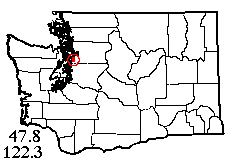 |
![]() 17 XII 2006: It was the driest day in six weeks (and perhaps the last
for 6 more), so even though the region was still recovering from a major windstorm,
I decided to try my luck at Southwest
County Park near Browns Bay west of Lynnwood and Edmonds. Bus connections
went smoothly and I easily found my planned access point - but what looked like
a trail on aerial photos was really a linear alder swamp. I did manage to find
a very rough trail nearby, though, partly undermined by mountain beavers and
often buried by windfall boughs. This route brought me to a lovely looking spot
on the steep ravine side of Perrinville Creek, well past the last outpost of
invasive ivy (fortunately, little blackberry was present). In late fall, leaf
litter (especially maple) is the most productive habitat in lowland forest.
Unfortunately, maples were lacking, and alders limited to the swamp and the
ravine bottom. Some alder-fir litter here produced very little - but I should
have persisted, because alder litter tried later back at the swamp produced
no spiders at all! The temperature wasn't much above freezing, and I presume
the spiders were present but just not moving. Ordinarily, I'd bring a big bag
of it back to the lab, but that's hard on a bus trip. Sifting moss did produce
a few more species; beating understory and conifer foliage yielded spiders in
almost normal numbers - but the identifiable ones belonged to disappointingly
few species. Result: a sub-adequate sample. If another suitable day presented
itself, I resolved on a return trip to check elsewhere for maples or other habitats.
This large park must have lots more species than I found!
17 XII 2006: It was the driest day in six weeks (and perhaps the last
for 6 more), so even though the region was still recovering from a major windstorm,
I decided to try my luck at Southwest
County Park near Browns Bay west of Lynnwood and Edmonds. Bus connections
went smoothly and I easily found my planned access point - but what looked like
a trail on aerial photos was really a linear alder swamp. I did manage to find
a very rough trail nearby, though, partly undermined by mountain beavers and
often buried by windfall boughs. This route brought me to a lovely looking spot
on the steep ravine side of Perrinville Creek, well past the last outpost of
invasive ivy (fortunately, little blackberry was present). In late fall, leaf
litter (especially maple) is the most productive habitat in lowland forest.
Unfortunately, maples were lacking, and alders limited to the swamp and the
ravine bottom. Some alder-fir litter here produced very little - but I should
have persisted, because alder litter tried later back at the swamp produced
no spiders at all! The temperature wasn't much above freezing, and I presume
the spiders were present but just not moving. Ordinarily, I'd bring a big bag
of it back to the lab, but that's hard on a bus trip. Sifting moss did produce
a few more species; beating understory and conifer foliage yielded spiders in
almost normal numbers - but the identifiable ones belonged to disappointingly
few species. Result: a sub-adequate sample. If another suitable day presented
itself, I resolved on a return trip to check elsewhere for maples or other habitats.
This large park must have lots more species than I found!
 |
![]() 29 XII 2006: The year was almost over and Friday had a "zero percent"
chance of rain, plus I hoped to get some kinks out of my leg muscles by vigorous
activity, so the return trip to Southwest County Park became a reality - almost.
I'd been off the bus for about 2 minutes when the clouds began to sprinkle.
Rain (albeit light) kept up for the next hour. So I changed to a somewhat closer
goal, Lynndale
Park, smaller but still with a decent-sized forest tract, in hopes of finding
a bagful of maple leaf litter before it got too wet. Fortunately the rain stopped,
but I liked the looks of the smaller park (invasive plants present but not dominant)
and stayed there. A half hour's searching finally brought me to a small maple
grove dominated by one huge tree (see album).
I'd come prepared with an especially sturdy plastic bag to bring a litter sample
back to the Berlese funnel, subject to how tolerant the bus drivers were today.
Just to make sure, I sifted a little relatively dry litter that I found near
the picnic shelter, though the rising wind threatened to blow my cloth away.
Voila - spiders! In my short stay at the park, I also checked out park buildings
(2 dead summer spiders, each adding a record) and some nice looking salal understory
foliage with little result, but the litter was the thing, and adequately supplemented
the previous poor sample. And yes, I got the bag of leaves home, with scarcely
even a dirty look.
29 XII 2006: The year was almost over and Friday had a "zero percent"
chance of rain, plus I hoped to get some kinks out of my leg muscles by vigorous
activity, so the return trip to Southwest County Park became a reality - almost.
I'd been off the bus for about 2 minutes when the clouds began to sprinkle.
Rain (albeit light) kept up for the next hour. So I changed to a somewhat closer
goal, Lynndale
Park, smaller but still with a decent-sized forest tract, in hopes of finding
a bagful of maple leaf litter before it got too wet. Fortunately the rain stopped,
but I liked the looks of the smaller park (invasive plants present but not dominant)
and stayed there. A half hour's searching finally brought me to a small maple
grove dominated by one huge tree (see album).
I'd come prepared with an especially sturdy plastic bag to bring a litter sample
back to the Berlese funnel, subject to how tolerant the bus drivers were today.
Just to make sure, I sifted a little relatively dry litter that I found near
the picnic shelter, though the rising wind threatened to blow my cloth away.
Voila - spiders! In my short stay at the park, I also checked out park buildings
(2 dead summer spiders, each adding a record) and some nice looking salal understory
foliage with little result, but the litter was the thing, and adequately supplemented
the previous poor sample. And yes, I got the bag of leaves home, with scarcely
even a dirty look.
25 field days in 2006, best total for Washington collecting since the '90s.
This page last updated 7 April, 2024